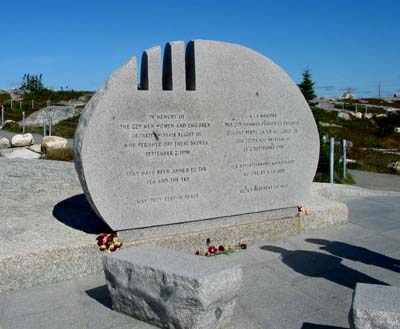| 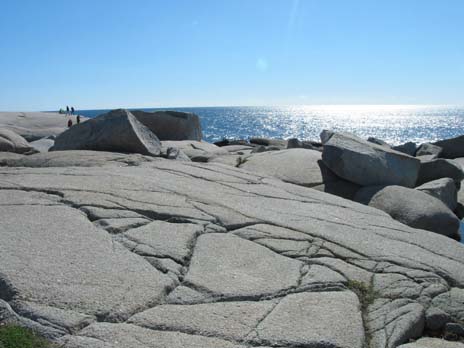
To the lighthouse
It’s a hauntingly beautiful
landscape; difficult to describe in words. Easy walking paths weave
over and through the vast field of smooth ancient rocks. Perched
on the rounded rocks near the ocean is the famous red-and-white
de-commissioned lighthouse — a post office in summer —
that has become one of world’s most photographed. And like
a magnet, the rocks and water pull me to come and explore each time
I return to Peggy's Cove. But I do heed the cautions about rock-walking
close to the ocean; numerous signs warn of rogue waves that can,
and each year do, carry people off the rocks into the ocean.
Rock walking has been a long-time passion of mine and at Peggy’s
Cove, I’ve always rushed straight to these magnificent boulders
by the ocean. Normally I whiz through the village, barely giving
it a glance. After a few hours on the rocks, I usually hop back
into the car and like the many daily tourist buses, leave the scene.
But this was not the case on my most recent visit.
The village of
Peggy’s Cove
This time I decided to wander the narrow
streets of this historic little village (population 76) which was
founded in 1811 when six families of German descent were granted
land of 800 acres by the Nova Scotia government. Most were fisherman
who also farmed and raised cattle.
Peggy’s Cove continues to be a working
community in the 21st century, with Cape Island boats still going
out to sea for lobster fishing. It is a delightful place to walk
along the narrow winding streets with its colourful painted houses,
visit locally-owned little shops (like Beale’s
Bailiwick) or look at the fishing boats tied up on
Murray’s Wharf.
The Whalesback
One kilometre northwest of Peggy’s
Cove is another dramatic place — The
Whalesback — now also the site of a memorial
for the Swissair Flight 111 disaster of 1998. (It wasn’t here
on my previous visit.) Actually, there are two memorials in Nova
Scotia commemorating those who died as a result of this tragedy:
the Whalesback which looks out toward the original crash site on
St. Margaret’s Bay; and Bayswater
with its memorial wall containing the names of the 229 passengers
and crew, and a mass grave containing the unidentified remains.
The two memorials and the site of the crash
form a triangle.
The Whalesback stone monument is set in a beautiful, rugged terrain
of huge granite boulders, rock croppings and low shrubbery. It has
always reminded me of the barren lands of Canada’s Northwest
Territories. Like the landscape in Canada’s north, this was
now a landscape that I discovered reached deep into my soul.
The Whalesback is a popular stop for tourists;
the parking lot was full of cars with license plates from all over
North America. From the lot, a short walk on a gravel path leads
to the ocean and the site of the monument. In English and French,
it reads,
“In memory of the 229 men, women
and children aboard Swissair Flight 111 who perished off these
shores September 2nd, 1998. They have been joined to the sea,
and the sky. May they rest in peace.”
A sanctuary by the ocean
About a five-minute drive from Peggy’s
Cove was our lodgings, the Oceanstone Inn & Cottages (a member
of Nova Scotia’s Association of Unique Country Inns). And
what a fabulous place it was. Seven cottages sit right by the water’s
edge. The rooms and suites at the inn are spacious (most with great
ocean views) and the innkeepers, Ron and Carole MacInnis, are wonderful,
warm people. (I immediately felt as if we were old friends; much
in keeping with the famed Maritime culture.) I chuckled when Ron
told me that people sometimes mistake him for the gardener, but
his wonderful landscaping definitely adds a beautiful “wow”
factor to the property.
On site there is an excellent massage therapy
studio, Healthself Therapeutics with registered massage therapists
Meigan and Rachel. There are lots of options to choose from in both
therapeutic or relaxation massage: Swedish, hot stone, Reiki, aromatherapy,
myofascial, craniosacral.
What made Oceanstone particularly special
for me was its sanctuary-like setting by the ocean. Coffee in hand,
I would wander down the path to the natural open space that the
Mi’kmaq blessed as sacred ground. Looking out
at the ocean and the unspoiled view from my Adirondack chair, I
began to feel a sense of reconnection. Time seemed to have dissipated;
I was truly living in the moment. It was a powerful and relatively
new sensation for me.
I felt what I can only call a spiritual energy;
something both soothing and energizing. Somewhere I read or heard
that the famous sleeping prophet/psychic Edgar
Cayce had said that in Nova Scotia there is an energy
spot that can change the world. Could this be the spot?
Spiritual travel
Each time I visit this part of Nova Scotia,
the landscape seems to grow even more dramatic and more powerful.
As I get older I feel as if I am seeing nature and its landscapes
in a more focussed and intense way. Recently I read that baby boomers
(my generation) is the avant garde in a new trend in travel and
tourism; exploring “spiritual” places and destinations
that “touch the soul.” This is what I now experience
when I revisit the sea, rocks and nature of Nova
Scotia’s Lighthouse Route on the province's eastern
shore.
For More Information
Nova Scotia Department of Tourism,
Culture & Heritage
P.O. Box 456,
Halifax NS Canada
B3J 2R5
Toll-free 1-800-565-0000 (within North America)
Local & Outside North America 902.425.5781
Fax 902.424.2668
Website: www.novascotia.com
Nova Scotia Association of Unique
Country Inns
Website:
www.uniquecountryinns.com
Oceanstone Inn & Cottages,
8650 Peggy’s Cove Road
Indian Harbour, Nova Scotia B3Z 3P4
Toll-free 1-866-823-2160
Fax 902.823.1282
Website: www.oceanstone.ns.ca
At Oceanstone, it is just a short walk up
the driveway to the come-as-you-are fine seaside dining at the Rhubarb
Grill & Café. Owned and operated by the MacInnis’s
son and chef Paul, the food is superb and the service world-class.
For dinner, I had “Butter Poached Lobster Tail,” a 3-4
ounce lobster tail with sliced mango warmed in a lemon grass and
kaffir lime infused coconut broth.
“. . . so that the monotonous
fall of the waves on the beach, which for the most part beat a measured
and soothing tattoo to her thoughts seemed consolingly to repeat
over and over again as she sat with the children the words of some
old cradle song, murmured by nature, ‘I am guarding you —
I am your support," but at other times suddenly and unexpectedly,
especially when her mind raised itself slightly from the task actually
in hand, had no such kindly meaning, but like a ghostly roll of
drums remorsely beat the measure of life, made one think of the
destruction of the island and its engulfment in the sea, and warned
her whose day had slipped past in one quick doing after another
that it was all ephemeral as a rainbow — this sound which
had been obscured and concealed under the other sounds suddenly
thundered hollow in her ears and made her look up with an impulse
of terror.” — from To the Lighthouse, by Virginia
Woolf
|
Nova
Scotia: Soothing the Soul
by Elle Andra-Warner 
There’s something quite extraordinary about standing
on the large granite glacier-smoothed boulders at Peggy’s Cove
on Nova Scotia’s eastern shore and gazing out on the waters
of the Atlantic Ocean.
I’ve
been there numerous times yet on my last visit, the scene was even
more dramatic.
Located
43 kilometres (27 miles) southwest of downtown Halifax, Peggy’s
Cove — with its typical Maritime fishing village, rocky landscape
and lighthouse — is situated on the eastern shore of St. Margaret’s
Bay. It is one of the most popular tourist spots in Atlantic Canada.
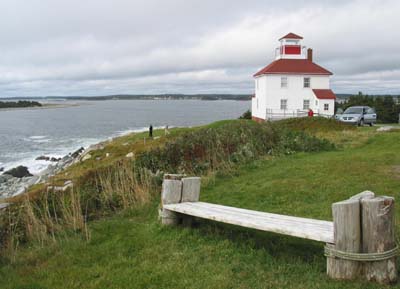
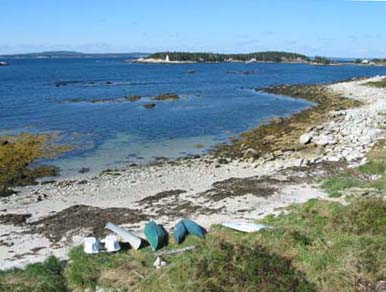
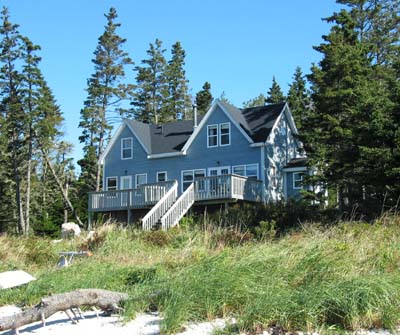
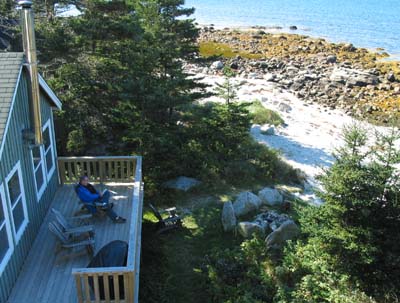
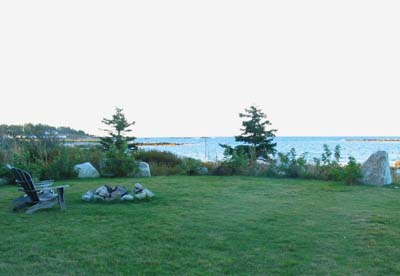

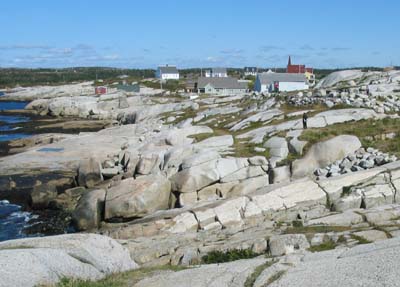

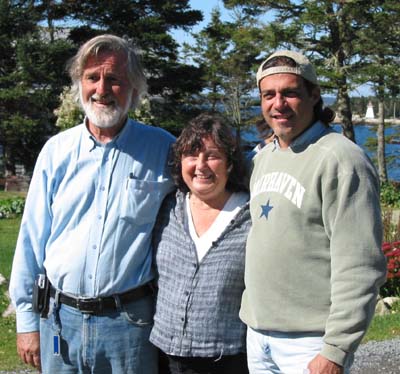
|










